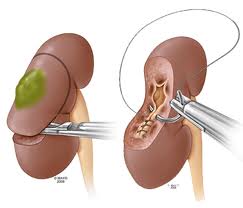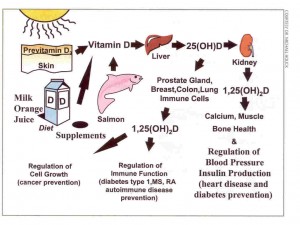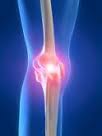 High-dose vitamin D relieves joint and muscle pain for many breast cancer patients taking estrogen-lowering drugs, according to a new study from Washington University School of Medicine in St. Louis.
High-dose vitamin D relieves joint and muscle pain for many breast cancer patients taking estrogen-lowering drugs, according to a new study from Washington University School of Medicine in St. Louis.
The drugs, known as aromatase inhibitors, are commonly prescribed to shrink breast tumors fueled by the hormone estrogen and help prevent cancer recurrence. They are less toxic than chemotherapy, but for many patients, the drugs may cause severe musculoskeletal discomfort, including pain and stiffness in the hands, wrists, knees, hips, lower back, shoulders and feet.
"About half of patients can experience these symptoms," says Antonella L. Rastelli, MD, assistant professor of medicine and first author of the study published online in the journal Breast Cancer Research and Treatment. "We don't know exactly why the pain occurs, but it can be very debilitating to the point that patients decide to stop taking aromatase inhibitors."
Because the drugs reduce cancer recurrence, finding a way to help patients stay on them is important for long-term, relapse-free survival, according to Rastelli. Aromatase inhibitors are prescribed to post-menopausal women for at least five years and often longer after a breast cancer diagnosis. There is some evidence that patients who experience the drugs' side effects are less likely to see their cancer return, providing even more incentive to help these patients continue taking them.
It was Rastelli's colleague, Marie E. Taylor, MD, assistant professor of radiation oncology, who first noticed that patients on aromatase inhibitors who experienced this pain found some relief from high doses of vitamin D.
So Rastelli's group recruited 60 patients who reported pain and discomfort associated with anastrozole, one of three FDA-approved aromatase inhibitors. The patients they studied also had low vitamin D levels. Half the group was randomly assigned to receive the recommended daily dose of vitamin D (400 international units) plus a 50,000-unit vitamin D capsule once a week. The other half received the daily dose of 400 units of vitamin D plus a weekly placebo. All subjects received 1,000 milligrams of calcium daily throughout the study.
Patients in the study reported any pain they experienced through three different questionnaires. They were asked to quantify their pain intensity, as well as report how much the pain altered their mood, affected their work and interfered with relationships and daily activities. The results show that patients receiving high-dose vitamin D every week reported significantly less musculoskeletal pain and also were less likely to experience pain that interfered with daily living.
"High-dose vitamin D seems to be really effective in reducing the musculoskeletal pain caused by aromatase inhibitors," Rastelli says. "Patients who get the vitamin D weekly feel better because their pain is reduced and sometimes goes away completely. This makes the drugs much more tolerable. Millions of women worldwide take aromatase inhibitor therapy, and we may have another 'tool' to help them remain on it longer."
Like anastrozole used in this study, the other two FDA-approved aromatase inhibitors, letrozole and exemestane, also cause musculoskeletal pain. Given the similar side effects, Rastelli says patients on these drugs may also benefit from high-dose vitamin D.
The vitamin used in this study is a plant-derived type called vitamin D2. Rastelli says it achieves the best results when given weekly because the body metabolizes it within seven to 10 days. Rastelli and her colleagues did not use high-dose vitamin D3, which remains in the body longer.
"This was a very carefully conducted study, and the placebo control makes the findings quite compelling," says Matthew J. Ellis, MD, PhD, the study's senior author and director of the Breast Cancer Program at the Alvin J. Siteman Cancer Center at Barnes-Jewish Hospital and Washington University School of Medicine in St. Louis. "We should follow up these findings further to determine the most efficacious and safe approach to vitamin D supplementation in our breast cancer patients."
Since vitamin D helps the body absorb calcium, too much of it can cause high levels of calcium in the urine, which may increase the risk of kidney stones. Such possible side effects emphasize the importance of tracking patients' urine calcium levels while taking high-dose vitamin D.
"It's important to monitor the patients, but overall it appears to be very safe," Rastelli says. "Because vitamin D2 is eliminated from the body so quickly, it's very hard to overdose."
In addition to relieving pain, the group wanted to examine whether vitamin D could protect against the bone loss often seen in patients taking aromatase inhibitors. The researchers measured each patient's bone density at the beginning of the study and again after six months.
Perhaps because of its role in calcium absorption, high-dose vitamin D did appear to help maintain bone density at the neck of the femur, the top of the thighbone near the hip joint. Although the result did not reach statistical significance, Rastelli calls the result promising and worth further studies.
"It's great that we have something as simple as vitamin D to help patients alleviate some of this pain," Rastelli says. "It's not toxic it doesn't cause major side effects. And if it is actually protecting against bone loss, that's even better."
Rastelli AL, Taylor ME, Gao F, Armamento-Villareal R, Jamalabadi-Majidi S, Napoli N, Ellis MJ. Vitamin D and aromatase inhibitor-induced musculoskeletal symptoms (AIMSS): a phase II, double-blind, placebo-controlled, randomized trial. Breast Cancer Research and Treatment. Online June 2011.
Source: Washington University in St. Louis
 The FDA approved Botox injection to treat urinary incontinence (UI) in people with neurologic bladder conditions such as spinal cord injury and multiple sclerosis who have over activity of the bladder. The effectiveness of Botox to treat this type of incontinence was demonstrated in two clinical studies involving 691 patients. Both studies showed statistically significant decreases in the weekly frequency of incontinence episodes in the Botox group compared with placebo.
The FDA approved Botox injection to treat urinary incontinence (UI) in people with neurologic bladder conditions such as spinal cord injury and multiple sclerosis who have over activity of the bladder. The effectiveness of Botox to treat this type of incontinence was demonstrated in two clinical studies involving 691 patients. Both studies showed statistically significant decreases in the weekly frequency of incontinence episodes in the Botox group compared with placebo.
 Concierge or boutique medicine is growing as busy people of means look for a way to bypass the red tape, waiting times, and inconveniences that may accompany a visit to the doctor. On the physicians' side, doctors, including primary care physicians have joined concierge groups to avoid the long hours, incessant forms and high overhead of an overworked, understaffed practice.
Concierge or boutique medicine is growing as busy people of means look for a way to bypass the red tape, waiting times, and inconveniences that may accompany a visit to the doctor. On the physicians' side, doctors, including primary care physicians have joined concierge groups to avoid the long hours, incessant forms and high overhead of an overworked, understaffed practice. As more primary care providers join concierge practices, less physicians are available to provide general medicine to the masses. This causes a larger workload for the physicians who are left in the mainstream. This could lead to lower quality care because visits will be shortened and patients will be referred to see more physician extenders like physician assistants, nurse practitioners, etc. Not that there is anything wrong with these compassionate and dedicated caregivers who can handle the majority of stomach aches and ear infections (and sometimes are preferred to a busy doctor). But what about the prediabetic, the child with funny looking blood cells. Sure, the PA or NP can refer any unusual symptoms to the doctor on duty (if they can catch them between appointments!). But this only adds to the time needed to get a problem diagnosed and treated. The result could be less healthy patients who often miss the advantage of preventive care.
As more primary care providers join concierge practices, less physicians are available to provide general medicine to the masses. This causes a larger workload for the physicians who are left in the mainstream. This could lead to lower quality care because visits will be shortened and patients will be referred to see more physician extenders like physician assistants, nurse practitioners, etc. Not that there is anything wrong with these compassionate and dedicated caregivers who can handle the majority of stomach aches and ear infections (and sometimes are preferred to a busy doctor). But what about the prediabetic, the child with funny looking blood cells. Sure, the PA or NP can refer any unusual symptoms to the doctor on duty (if they can catch them between appointments!). But this only adds to the time needed to get a problem diagnosed and treated. The result could be less healthy patients who often miss the advantage of preventive care. Researchers at the University of California, San Diego School of Medicine have shed new light on how surgery impacts both chronic kidney disease and bone health, particularly in women. For the first time, their findings point to the importance of pursuing kidney-sparing surgery in an effort to preserve kidney function and to reduce the risk of bone fractures later in life. The study was published in the July 19 edition of Urology and is now available online.
Researchers at the University of California, San Diego School of Medicine have shed new light on how surgery impacts both chronic kidney disease and bone health, particularly in women. For the first time, their findings point to the importance of pursuing kidney-sparing surgery in an effort to preserve kidney function and to reduce the risk of bone fractures later in life. The study was published in the July 19 edition of Urology and is now available online. The sex hormone estrogen could help protect women from cardiovascular disease by keeping the body's immune system in check, new research from Queen Mary, University of London has revealed.
The sex hormone estrogen could help protect women from cardiovascular disease by keeping the body's immune system in check, new research from Queen Mary, University of London has revealed. Due to the growing interest in Vitamin D, we featured that fat soluble vitamin in our August e-newsletter which can viewed by clicking
Due to the growing interest in Vitamin D, we featured that fat soluble vitamin in our August e-newsletter which can viewed by clicking  High-dose vitamin D relieves joint and muscle pain for many breast cancer patients taking estrogen-lowering drugs, according to a new study from Washington University School of Medicine in St. Louis.
High-dose vitamin D relieves joint and muscle pain for many breast cancer patients taking estrogen-lowering drugs, according to a new study from Washington University School of Medicine in St. Louis. Being physically active is one of best ways people with arthritis can improve their health, but a new study from Northwestern University Feinberg School of Medicine shows that more than half of women and 40 percent of men with arthritis are virtually couch potatoes.
Being physically active is one of best ways people with arthritis can improve their health, but a new study from Northwestern University Feinberg School of Medicine shows that more than half of women and 40 percent of men with arthritis are virtually couch potatoes. Munching more unprocessed plant foods may help keep the middle-aged bulge away (AKA muffin top) , a new study suggests. On the other hand, meat, french fries and sugar-sweetened drinks can help pack on the pounds. The findings suggest that the types of food you choose, not just calories, are important for avoiding age-related weight gain.
Munching more unprocessed plant foods may help keep the middle-aged bulge away (AKA muffin top) , a new study suggests. On the other hand, meat, french fries and sugar-sweetened drinks can help pack on the pounds. The findings suggest that the types of food you choose, not just calories, are important for avoiding age-related weight gain.
 A Mayo Clinic orthopedic surgeon suspects that the nagging pain and inflammation that women can experience in their knees may be different from what men encounter, and she has been chosen to lead a novel U.S.-Canadian study to explore the question. The Society for Women’s Health Research (SWHR) has awarded a group of researchers a grant to lead a pilot project to understand whether biological differences between men and women affect the incidence and severity of knee osteoarthritis. Mary I. O’Connor, M.D., chair of the Department of Orthopedic Surgery at Mayo Clinic’s campus in Florida, will be the study’s principal investigator.
A Mayo Clinic orthopedic surgeon suspects that the nagging pain and inflammation that women can experience in their knees may be different from what men encounter, and she has been chosen to lead a novel U.S.-Canadian study to explore the question. The Society for Women’s Health Research (SWHR) has awarded a group of researchers a grant to lead a pilot project to understand whether biological differences between men and women affect the incidence and severity of knee osteoarthritis. Mary I. O’Connor, M.D., chair of the Department of Orthopedic Surgery at Mayo Clinic’s campus in Florida, will be the study’s principal investigator.